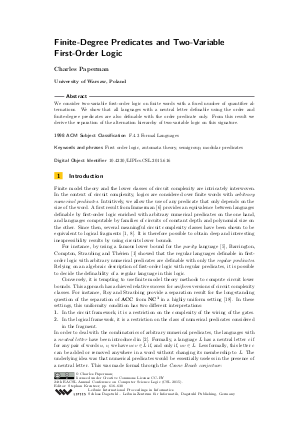Finite-Degree Predicates and Two-Variable First-Order Logic
Author Charles Paperman
-
Part of:
Volume:
24th EACSL Annual Conference on Computer Science Logic (CSL 2015)
Part of: Series: Leibniz International Proceedings in Informatics (LIPIcs)
Part of: Conference: Computer Science Logic (CSL) - License:
 Creative Commons Attribution 3.0 Unported license
Creative Commons Attribution 3.0 Unported license
- Publication Date: 2015-09-07
File

PDF
LIPIcs.CSL.2015.616.pdf
- Filesize: 425 kB
- 15 pages
Document Identifiers
Subject Classification
Keywords
- First order logic
- automata theory
- semigroup
- modular predicates
Metrics
- Access Statistics
-
Total Accesses (updated on a weekly basis)
0Document
0Metadata
Abstract
We consider two-variable first-order logic on finite words with a fixed number of quantifier alternations. We show that all languages with a neutral letter definable using the order and finite-degree predicates are also definable with the order predicate only. From this result we derive the separation of the alternation hierarchy of two-variable logic on this signature. Replacing finite-degree by arbitrary numerical predicates in the statement would entail a long standing conjecture on the circuit complexity of the addition function. Thus, this result can be viewed as a uniform version of this circuit lower bound.
Cite As Get BibTex
Charles Paperman. Finite-Degree Predicates and Two-Variable First-Order Logic. In 24th EACSL Annual Conference on Computer Science Logic (CSL 2015). Leibniz International Proceedings in Informatics (LIPIcs), Volume 41, pp. 616-630, Schloss Dagstuhl – Leibniz-Zentrum für Informatik (2015)
https://doi.org/10.4230/LIPIcs.CSL.2015.616
BibTex
@InProceedings{paperman:LIPIcs.CSL.2015.616,
author = {Paperman, Charles},
title = {{Finite-Degree Predicates and Two-Variable First-Order Logic}},
booktitle = {24th EACSL Annual Conference on Computer Science Logic (CSL 2015)},
pages = {616--630},
series = {Leibniz International Proceedings in Informatics (LIPIcs)},
ISBN = {978-3-939897-90-3},
ISSN = {1868-8969},
year = {2015},
volume = {41},
editor = {Kreutzer, Stephan},
publisher = {Schloss Dagstuhl -- Leibniz-Zentrum f{\"u}r Informatik},
address = {Dagstuhl, Germany},
URL = {https://drops.dagstuhl.de/entities/document/10.4230/LIPIcs.CSL.2015.616},
URN = {urn:nbn:de:0030-drops-54420},
doi = {10.4230/LIPIcs.CSL.2015.616},
annote = {Keywords: First order logic, automata theory, semigroup, modular predicates}
}
Author Details
References
-
David A. Mix Barrington, Kevin Compton, Howard Straubing, and Denis Thérien. Regular languages in NC \sp 1. J. Comput. System Sci., 44(3):478-499, 1992.

-
David A. Mix Barrington, Neil Immerman, Clemens Lautemann, Nicole Schweikardt, and Denis Thérien. First-order expressibility of languages with neutral letters or: The Crane Beach conjecture. J. Comput. System Sci., 70(2):101-127, 2005.

-
AshokK. Chandra, Steven Fortune, and Richard Lipton. Lower bounds for constant depth circuits for prefix problems. In Josep Diaz, editor, Automata, Languages and Programming, volume 154 of Lecture Notes in Computer Science, pages 109-117. Springer Berlin Heidelberg, 1983.

-
Shiva Chaudhuri and Jaikumar Radhakrishnan. Deterministic restrictions in circuit complexity. In Proceedings of the Twenty-eighth Annual ACM Symposium on the Theory of Computing (Philadelphia, PA, 1996), pages 30-36. ACM, New York, 1996.

-
Merrick L. Furst, James B. Saxe, and Michael Sipser. Parity, circuits, and the polynomial-time hierarchy. Mathematical Systems Theory, 17(1):13-27, 1984.

-
Neil Immerman. Languages that capture complexity classes. SIAM J. Comput., 16(4):760-778, 1987.

-
Michal Koucký. Circuit complexity of regular languages. Theory Comput. Syst., 45(4):865-879, 2009.

-
Michal Koucký, Clemens Lautemann, Sebastian Poloczek, and Denis Therien. Circuit lower bounds via ehrenfeucht-fraisse games. In Proceedings of the 21st Annual IEEE Conference on Computational Complexity, CCC'06, pages 190-201, Washington, DC, USA, 2006. IEEE Computer Society.

-
Michal Koucký, Pavel Pudlák, and Denis Thérien. Bounded-depth circuits: Separating wires from gates. In Proceedings of the 37th Annual ACM Symposium on Theory of Computing, STOC'05, pages 257-265, New York, NY, USA, 2005. ACM.

-
Andreas Krebs and Pierre Mckenzie. Private communication.

-
Andreas Krebs and A. V. Sreejith. Non-definability of languages by generalized first-order formulas over (ℕ,+). In Proceedings of the 27th Annual IEEE/ACM Symposium on Logic in Computer Science, LICS'12, pages 451-460, Washington, DC, USA, 2012. IEEE Computer Society.

-
Andreas Krebs and Howard Straubing. An effective characterization of the alternation hierarchy in two-variable logic. In Proceedings of the 32th international conference on Foundations of Software Technology and Theoretical Computer Science (FSTTCS'12), volume 18 of LIPIcs - Leibniz International Proceedings in Informatics, pages 86-98, Dagstuhl, Germany, 2012. Schloss Dagstuhl - Leibniz-Zentrum für Informatik.

-
Manfred Kufleitner and Alexander Lauser. Quantifier alternation in two-variable first-order logic with successor is decidable. In Proceedings of the 30th International Symposium on Theoretical Aspects of Computer Science, STACS'13, pages 305-316. Schloss Dagstuhl - Leibniz-Zentrum für Informatik, 2013.

-
Manfred Kufleitner and Pascal Weil. The FO \sp 2 alternation hierarchy is decidable. In Computer science logic 2012, volume 16 of LIPIcs - Leibniz International Proceedings in Informatics, pages 426-439. Schloss Dagstuhl - Leibniz-Zentrum für Informatik, 2012.

-
Leonid Libkin. Elements of Finite Model Theory. Springer, 2004.

-
Prabhakar Ragde and Avi Wigderson. Linear-size constant-depth polylog-threshold circuits. Inform. Process. Lett., 39(3):143-146, 1991.

-
Frank P. Ramsey. On a Problem of Formal Logic. Proc. London Math. Soc., S2-30(1):264, 1930.

-
Amitabha Roy and Howard Straubing. Definability of languages by generalized first-order formulas over (\Bbb N,+). SIAM J. Comput., 37(2):502-521 (electronic), 2007.

-
Philipp Weis and Neil Immerman. Structure theorem and strict alternation hierarchy for FO \sp 2 on words. Log. Methods Comput. Sci., 5(3):3:4, 23, 2009.

